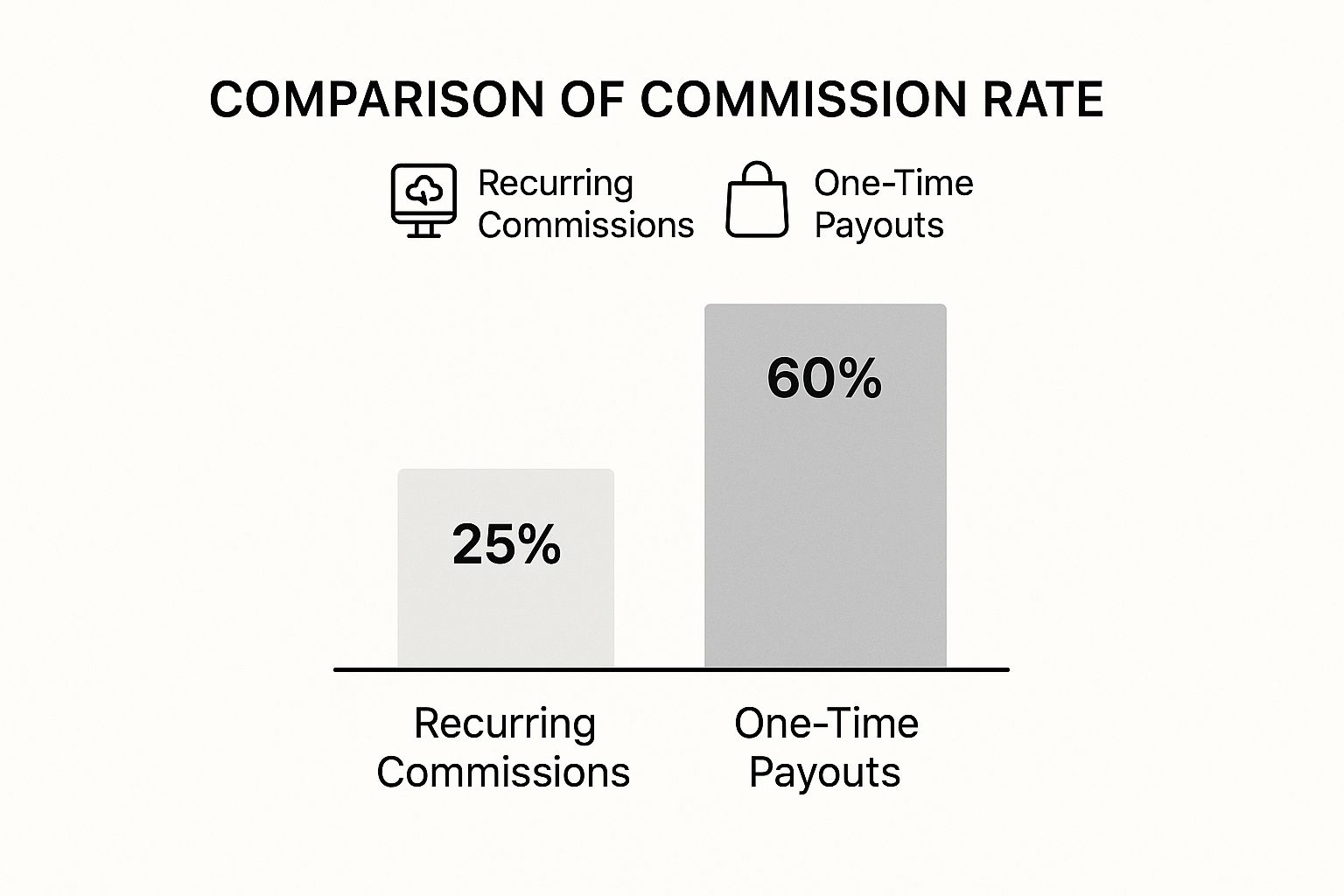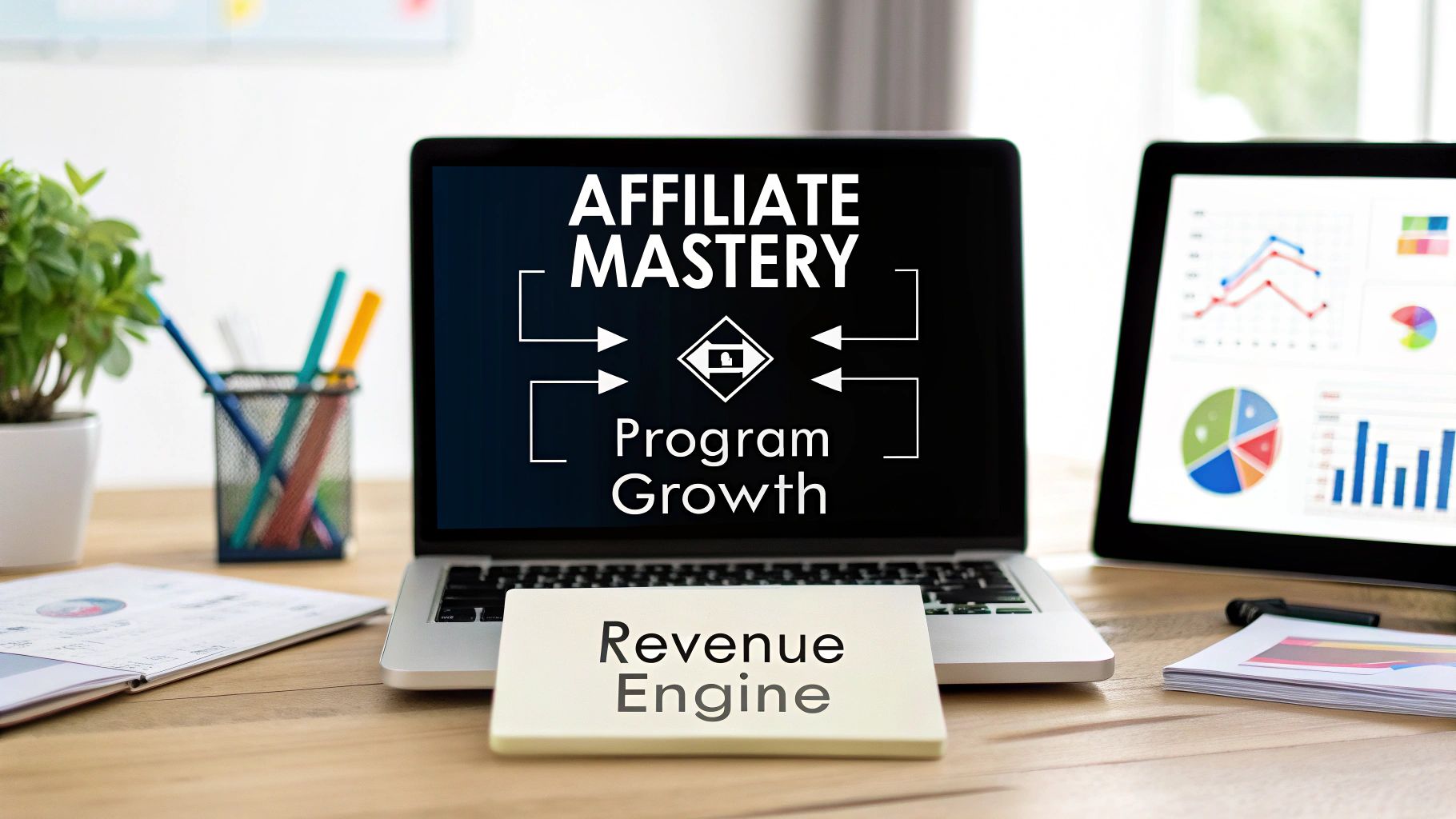Think of a software affiliate program as a smart, modern-day referral system. Instead of getting a free coffee for bringing a friend to your local shop, you earn a real commission every time someone buys a digital tool through your recommendation. It's a performance-based model that works out for everyone—companies get a powerful new sales channel, and promoters get a scalable way to earn money.
How Software Affiliate Programs Actually Work

At its heart, a software affiliate program is a simple partnership. On one side, you have a company that builds a great digital product. On the other, you have an individual or business—the affiliate—who promotes it to their audience. The whole system runs on trust and technology, working behind the scenes to connect the right product with the right people.
This is much more than just sticking a link on a website. It’s a sophisticated ecosystem where everyone benefits. The numbers back this up, with the global affiliate marketing platform market expected to jump from US$ 15 billion in 2025 to nearly US$ 28.7 billion by 2031, as projected by Infinity Market Research.
The Core Mechanics Explained
The real magic happens through a few key technical pieces working in sync. When you join a program as an affiliate, you're given a unique tracking link. Think of this URL as your personal digital fingerprint—it contains a special ID that's tied only to you.
When a potential customer clicks that link, a tiny file called a cookie is saved to their browser. This cookie's job is to remember that you were the one who sent them. It has a set lifespan, often called a "cookie duration," which might be anywhere from 24 hours to 120 days. If that person buys the software anytime within that window, you get the credit. For a more detailed breakdown, you can check out our guide on tracking affiliate links.
The Key Players and Their Roles
To really get a handle on how these programs tick, it helps to know who's involved and what they’re trying to achieve. It really boils down to three main players who make the entire system work.
Here’s a quick look at who does what:
Key Players in a Software Affiliate Program
| Player | Role | Primary Goal |
|---|---|---|
| The Software Company | The creator of the digital product. | To get new customers in a cost-effective way by only paying for results. |
| The Affiliate | The promoter of the product (blogger, influencer, etc.). | To earn commissions by connecting their audience with genuinely useful software. |
| The Customer | The end-user who buys the software. | To find the right tool to solve a problem, often with guidance from a trusted source. |
This collaborative setup is what makes the model so powerful. The software company doesn't have to gamble on expensive ads; they only pay when a sale is actually made. And for affiliates, it provides a way to make money that's directly tied to the value and trust they've built with their audience.
The beauty of software affiliate programs is their efficiency. Companies avoid massive upfront advertising costs, and affiliates can monetize their content by recommending products they genuinely believe in. It’s a pure performance-based marketing channel.
Ultimately, this structure turns casual recommendations into a reliable business model. It lets affiliates build an income from their expertise while helping software companies grow their user base through a trusted, distributed network of promoters. The entire process—from that first click to the final commission payment—is automated, transparent, and built for growth.
Unlocking Your Earning Potential as a Software Affiliate
So, where does the real magic of software affiliate programs come from? It all boils down to the economics. Promoting a physical product means someone has to account for manufacturing, shipping, and storage. Digital products? They have almost zero fulfillment costs.
This simple fact allows software companies to be incredibly generous with their commission structures. It opens up a direct and scalable path to a serious income for affiliates who know what they're doing.
It’s no surprise, then, that affiliate marketing has become a massive industry. By 2025, the market is expected to be worth around $18.5 billion, and some forecasts even predict it will hit $31.7 billion by 2031. The U.S. and the rest of North America are the biggest players, making up over 40% of that revenue, a fact you can explore in more detail with these affiliate marketing statistics from Hostinger.
At the heart of this financial engine are two main ways you get paid. Getting a handle on these is crucial for setting realistic goals.
Recurring Commissions: The Path to Predictable Income
The holy grail for most SaaS affiliates is the recurring commission. Think of it like this: you do the work to get someone to sign up once, but you keep getting paid month after month (or year after year) for as long as they stay a customer. It's like earning royalties on a hit song—the income just keeps rolling in.
This creates a stable, compounding income stream that can grow into something truly substantial.
For example, say you promote a project management tool that costs $50 a month. With a 20% recurring commission, you earn $10 every single month from that one referral. Now, imagine you refer 100 customers. Suddenly, you've built a $1,000 per month passive income stream that's there as long as those customers are happy. It's the model that many of the most successful software affiliate businesses are built on. If you're keen on this approach, our guide to SaaS affiliate programs goes into much greater detail.
One-Time Payouts: Big Wins, Right Now
On the flip side, you have one-time payouts, often called high-ticket commissions. This model is all about getting a large, immediate payment for each successful sale. You'll often see this with software sold as a lifetime license or a pricey annual plan.
Imagine you're promoting a specialized video editing suite that sells for a one-time price of $500. A juicy 50% commission would net you an instant $250 from just one sale. While it doesn't build that long-term, passive income like the recurring model, it delivers a quick and significant reward for your efforts.
This infographic breaks down the typical commission rates for each model.

As you can see, one-time payouts usually have a much higher percentage upfront, but recurring commissions are designed to build wealth steadily over time.
Key Takeaway: Your strategy really depends on your goals. Recurring commissions are for building a stable, long-term business. High-ticket, one-time payouts are perfect for generating immediate cash flow. The smartest affiliates often find a way to do both.
Ultimately, there's no single "best" option. The right strategy for you will align with what your audience needs and what your own financial goals are. By understanding how the money works, you can pick your partners wisely and focus your energy where it will deliver the biggest payoff in the world of software affiliate programs.
How to Choose a Winning Software Affiliate Program

Diving into software affiliate programs can feel like walking into a massive store with thousands of options lining the shelves. It’s easy to get distracted by the shiny packaging, but the best products aren't always the ones that shout the loudest. The real secret to long-term success isn't just about chasing the biggest commission rate; it's about finding a true partner whose product aligns perfectly with your audience, your brand, and your values.
Your reputation is everything. If you promote a buggy, overpriced, or totally irrelevant piece of software just for a quick buck, you risk breaking the trust you've worked so hard to build. A winning program is one where the product is so genuinely good you'd be recommending it anyway.
Look Beyond the Commission Rate
Let's be honest—the commission percentage is usually the first thing we all look at. But it's only one part of the story. A program offering a flashy 50% commission might seem like a no-brainer compared to one offering 20%, but that's a surface-level view.
What if that 20% program is for a SaaS tool with incredible customer loyalty? That means you could be earning recurring income for years from a single referral. This is where you need to dig a little deeper and analyze the details that really make a difference.
Here’s what I always check:
- Product Quality and Relevance: Is this a tool you actually believe in? Does it solve a genuine problem for your audience? It's always easier to sell something you're passionate about.
- Brand Reputation: What's the word on the street? Scour online reviews, social media comments, and industry forums. A strong, positive brand reputation does half the selling for you.
- Cookie Duration: This is the time window after someone clicks your link where you still get credit for a sale. A 90-day or 120-day cookie is gold, giving your referrals plenty of time to think things over without you losing the commission. A 24-hour cookie? Not so much.
- Affiliate Support: Is there a dedicated affiliate manager you can talk to? Do they provide marketing materials and creative assets? Good partners want you to succeed and will give you the tools to do it.
Choosing an affiliate program is like choosing a business partner. You're looking for reliability, shared values, and a mutual commitment to quality. The best partnerships are built on a foundation of trust and a genuinely great product.
Comparing Key Software Affiliate Program Metrics
To make this even clearer, let's break down the most important metrics in a table. Think of this as your quick-glance checklist when you're sizing up a new program.
| Metric | Why It Matters | What to Look For |
|---|---|---|
| Commission Rate | The percentage of a sale you earn. It directly impacts your potential income from each referral. | Look for competitive rates (20-50% is common for software), but don't let it be the only factor. |
| Commission Type | Determines if you get a one-time payout or recurring income for the life of the customer. | Recurring commissions are ideal for SaaS products as they provide a stable, long-term income stream. |
| Cookie Duration | The time frame your referral link remains active after a click. Longer is always better. | Aim for programs with 30 days or more. Anything less than that can be a red flag. |
| Payout Threshold | The minimum amount of commission you need to earn before you can get paid. | Lower thresholds ($50-$100) are preferable so you can access your earnings faster. |
| Product Value | A high-quality, in-demand product converts better and reflects well on your brand. | A product you'd personally use and recommend, backed by positive reviews and a solid reputation. |
This table isn't about finding a program that scores a perfect 10 in every category. It's about finding the right balance that works for your audience and your business model.
Understand the Terms and Conditions
Every affiliate program has a rulebook, and ignoring it is a fast track to losing commissions or even getting kicked out. Before you sign up, take the time to carefully read the affiliate program's terms of service. This document lays out everything from when you get paid to what you can and can't do to promote the product.
Keep an eye out for rules about paid ads (like bidding on their brand keywords), email marketing guidelines, and how you need to disclose your affiliate relationship. A few minutes of reading now can save you a world of headaches later.
Finding the Right Programs for Your Niche
Okay, so you know what to look for. Where do you find these amazing programs? Top-tier software affiliate programs tend to hang out in a few key places.
- Direct Company Websites: Many software companies, especially in the SaaS space, manage their own programs. Scroll down to the footer of their website and look for a link that says "Affiliates," "Partners," or "Referrals."
- Affiliate Networks: These are huge marketplaces connecting creators with thousands of brands. Platforms like PartnerStack, Impact, and ShareASale are go-to hubs for software companies, and they give you a central dashboard to track everything.
- Competitor Analysis: See what other successful creators in your niche are promoting. If a trusted voice in your field is recommending a tool, chances are the program is solid and the product is worth checking out.
Ultimately, the best program for you is a perfect mix of a killer product, fair terms, and a payment model that suits your goals. It's worth exploring different commission structure examples to figure out if you'd rather focus on recurring revenue or high-ticket, one-off payouts.
Proven Strategies to Promote Software and Drive Sales

Getting into a great software affiliate program is just the start. The real skill is learning how to promote the software in a way that feels genuinely helpful, not like a hard sell. At its core, successful affiliate marketing is about building trust by creating content that solves a real problem for your audience—with the software you're promoting as the ideal solution.
Forget about just scattering links and hoping for the best. Your mission is to become a trusted advisor. When you deliver real, tangible value, the conversions will follow. This approach doesn't just drive sales; it cements your authority in your niche, which makes every future promotion that much easier.
Master the Art of the In-Depth Product Review
The high-quality product review is the absolute foundation of a solid affiliate strategy. And I don't mean a quick summary of features pulled from a sales page. I'm talking about a deep dive into how the software actually performs in the real world. A great review is a story of your personal experience, showcasing the tool's strengths and, just as importantly, its limitations.
Here’s how to make your reviews truly connect with readers:
- Show, Don't Tell, with Real-World Use Cases: Instead of saying a project management tool is "good for teams," show them. Write a mini-case study on how you used it to wrangle a chaotic content calendar into a well-oiled machine.
- Use Your Own Screenshots and Videos: Stock images are a dead giveaway that you haven't actually used the product. Record your screen as you click through the dashboard, and use annotated screenshots to point out the features that matter most.
- Be Brutally Honest About the Downsides: No software is perfect. Pointing out a minor flaw or a feature you wish was designed differently makes your review far more credible. It builds a level of trust that a glowing, flawless review never could.
Create Compelling Comparison Articles
Your audience isn't always asking if they should buy something; they're often trying to decide which one to buy. This is where comparison posts shine. Pitting two or three popular software tools against each other is incredibly valuable for your audience and tends to convert exceptionally well.
Think of yourself as a guide simplifying a tough decision. A clean, easy-to-read table comparing key criteria—like features, pricing, ease of use, and customer support—is your best friend here. It lets readers quickly scan the information and see which tool fits their unique situation. By positioning yourself as an unbiased expert, you help them make a confident choice while earning their trust.
This kind of strategic content is why more than 80% of advertisers rely on affiliate marketing. For many brands, the average return is around $15 for every $1 spent. These numbers prove just how powerful trust-based promotion really is. You can dig deeper into the data by checking out these affiliate marketing performance statistics.
Develop Step-by-Step Tutorials and Guides
Tutorials are another content powerhouse because they deliver immediate, practical value. You’re not just reviewing a tool; you're showing someone how to achieve a specific goal with it. This type of content is a magnet for search traffic from people who are ready to take action.
A few tutorial ideas to get you started:
- "Getting Started" Guides: Help new users jump the first hurdle by walking them through the setup process.
- Advanced "How-To" Posts: Create content for the pros by showing them how to unlock a specific advanced feature for better results.
- Problem-Solution Content: Frame the tutorial around a common pain point, like "How to Automate Your Invoicing with [Software Name] in Under 10 Minutes."
Pro Tip: The magic is in weaving your affiliate links naturally into the tutorial steps. When someone sees the software solving their problem in real-time, clicking your link to sign up feels like the next logical step, not a sales pitch.
Leverage Email Marketing and Video Content
Don't box yourself in by only promoting on your blog. Your email list is a direct line to your most loyal followers, while video offers a dynamic and personal way to demonstrate a software's value.
With email, you could create a short-and-sweet mini-course or a tip series that highlights the software's benefits over a few days. For video, nothing beats a screen-recorded walkthrough or a "day in the life" style vlog that shows exactly how you integrate the tool into your workflow. Both of these channels allow you to build a much deeper connection and guide your audience toward a decision in a way that written text alone often can't match.
Building Your System for Affiliate Success
A brilliant plan is just a nice idea without a solid system to back it up. Once you’ve picked your software affiliate programs and mapped out your content, it’s time to build the engine that makes everything run. This is where you get down to business, setting up the tools and processes to manage, track, and grow your efforts.
Think of it as the cockpit of your affiliate business. Without a good system, you’re essentially flying blind. You won't know what’s working, what's a waste of time, or where your money is actually coming from. A well-built operational setup gives you the clarity to make smart decisions and scale your income.
Navigating Your Affiliate Dashboard
The first part of your system is the affiliate dashboard itself. This is your mission control, handed to you by the software company or the network you joined. Inside, you’ll find your unique tracking links, grab promotional assets, and—most importantly—keep an eye on your performance.
Getting comfortable with these numbers is absolutely essential.
- Clicks: This is the raw number of people who clicked your affiliate links. It’s a direct measure of how well your calls-to-action are grabbing attention.
- Conversions: This tracks how many of those clicks led to someone taking action, whether that’s signing up for a free trial or buying a subscription.
- Conversion Rate: This is the percentage of clicks that become conversions. If this number is low, it could mean there’s a mismatch between your audience and the product you’re promoting.
- Earnings Per Click (EPC): A super important metric that tells you, on average, how much money you make every time someone clicks your link.
Checking this data regularly helps you spot patterns. You might discover that one blog post is driving almost all your sales or that a particular email campaign is a click-through machine. This lets you double down on what’s actually working.
Essential Tools for Organization and Optimization
As you start joining more programs, trying to manage dozens of links in a spreadsheet quickly becomes a nightmare. It’s messy, inefficient, and a recipe for broken links and lost commissions. This is when dedicated tools stop being a luxury and start being a necessity.
The most successful affiliates treat their work like a business, not a hobby. This means investing in tools that create efficiency, provide clear data, and enable them to scale their operations without getting overwhelmed by manual tasks.
To keep everything running smoothly, it's worth looking into specialized affiliate marketing tools. For example, a good Lasso affiliate marketing tool review shows how platforms like it can help you organize all your links, create attractive product displays, and track performance across every program from one spot. These tools can save you a ton of time and give you insights that would be almost impossible to find on your own.
Maintaining Trust Through Transparency
Finally, the most important piece of your system isn't a tool or a dashboard—it's trust. Running a professional affiliate business means being upfront with your audience. In the U.S., the Federal Trade Commission (FTC) has clear rules that require you to disclose when you're using affiliate links.
But this isn't just about following the law; it's about being credible. A simple and clear disclosure at the top of your content—something like, "Just so you know, this post contains affiliate links, and I may earn a commission if you make a purchase"—builds honesty. It shows your audience you respect them, and that transparency is the foundation of a successful, long-term affiliate business.
Frequently Asked Questions
Jumping into the world of software affiliate programs can feel like learning a new language. You've probably got a ton of questions floating around. Let's tackle some of the most common ones head-on to clear things up and get you on the right track.
How Much Can I Realistically Earn?
This is the million-dollar question, isn't it? The honest answer is that your earnings can be anything from a little coffee money to a full-blown six-figure business. There’s no lottery ticket here; it all boils down to a few key things you have direct control over.
What really moves the needle on your income?
- Commission Rates: Software is famous for its generous commissions. For SaaS products, it's common to see recurring rates between 20-50%. That’s money that hits your bank account every single month.
- Product Price Point: Think about it: promoting a high-ticket B2B software can land you a massive one-time payout. We're talking hundreds, sometimes even thousands, from just one successful referral.
- Your Audience: A small, loyal group of people who hang on your every word is infinitely more valuable than a massive, disengaged crowd. Trust is your most valuable currency.
- Your Strategy: How you promote matters. Slapping links everywhere won't work. Creating genuinely helpful content—think deep-dive reviews, step-by-step tutorials, and honest comparison posts—is what truly converts.
If you want to build a serious, predictable income stream, focus your energy on high-value B2B software or products with that sweet, sweet recurring revenue model. That’s where the real long-term growth is.
What Are the Biggest Mistakes Beginners Make?
It’s easy to stumble when you’re just starting out. I've seen countless new affiliates make the same handful of mistakes. Sidestep these common pitfalls, and you’ll be miles ahead of the competition from day one.
Here’s what trips people up most often:
- Promoting Everything: It's tempting to sign up for every shiny new program you see. Don't. You'll spread yourself too thin and your audience won't know what you actually stand for. Pick a few core products you genuinely love and know inside and out.
- Chasing High Commissions: A 60% commission on a product that's impossible to sell is worth exactly zero. A great product that your audience actually needs is far more valuable, even with a lower commission. Quality and relevance always win.
- Forgetting to Build Trust: If your content feels like a used car salesman's pitch, people will tune out immediately. Focus on being a helpful resource, not a walking advertisement.
- Skipping the Disclosures: Always, always, always disclose your affiliate relationships. It's not just about being transparent and maintaining trust; in many places, it's the law.
- Flying Blind: If you aren't tracking your clicks and conversions, you have no idea what's working. Dive into your affiliate dashboard, see what resonates, and then do more of that.
The biggest mistake of all is focusing on making a sale instead of solving a problem. When you genuinely help people, the commissions become a natural result of the value you provide.
Do I Absolutely Need a Website to Be a Software Affiliate?
While a website or blog is hands-down the best asset you can build as an affiliate, it’s not the only way to play the game. You can find success on any platform where you've built a community that trusts you.
Here are a few other powerful platforms for software affiliates:
- YouTube: There's nothing quite like a video for showing software in action. Walkthroughs, tutorials, and review videos are incredibly persuasive.
- Email Newsletter: Your email list is a direct line to your most dedicated followers. It's the perfect place for sharing special offers and in-depth recommendations.
- Podcast: If you have an audience that loves to listen, you can talk about the tools you use and point them to affiliate links in your show notes.
- Niche Social Media Groups: A hyper-focused Facebook or LinkedIn group can be a goldmine, as long as you provide real value and respect the community's rules.
That said, a website gives you total control. It's your digital home base, a long-term asset that benefits from SEO, and the best foundation for building a sustainable business.
How Do Recurring Commissions Actually Work?
Recurring commissions are the secret sauce of SaaS affiliate marketing. This is how you build a stable, predictable income that doesn't start from zero every month. Instead of a one-off payment, you get paid over and over for the same referral.
It’s pretty simple. When you send a new customer to a subscription software (SaaS), you get a piece of their payment not just once, but every single time they renew. Month after month. Year after year.
Let’s run the numbers: say you promote a project management tool that costs $100 a month. The affiliate program offers a 30% recurring commission. For every single person you refer, you earn $30 every month they stay a customer. Get ten customers, and that's $300 a month. Get 100, and that's $3,000 a month—from referrals you might have made years ago. It’s a powerful way to stack your earnings and build a compounding income stream.
Ready to launch your own affiliate program without the complexity? Refgrow offers a fully embeddable, native affiliate marketing platform for SaaS. Get started in minutes, connect with our network of affiliates, and scale your growth. See how it works at refgrow.com.

